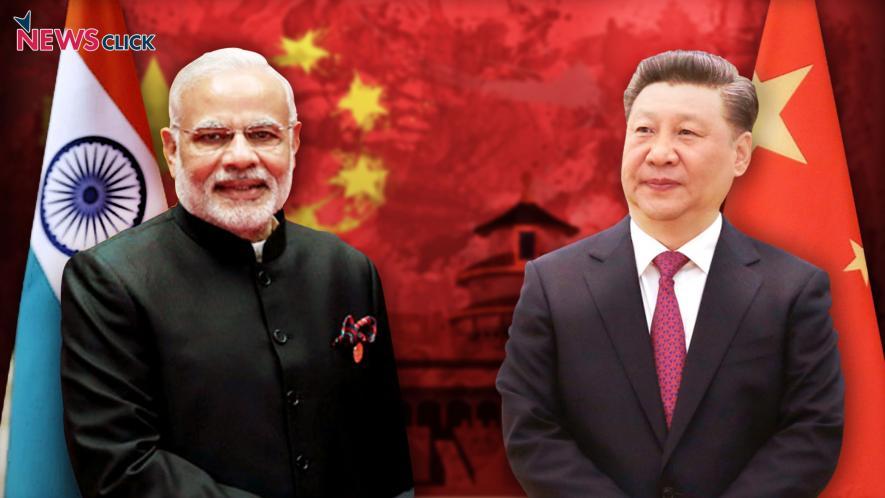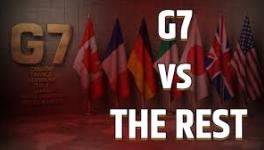The Political Economy of India-China Relations

A fundamental paradox underlies the Union government’s policy posture with respect to China. On the one hand, it is self-evident that India’s economic growth cannot be delinked from China given that it is the epicentre of world manufacturing in terms of production capacity, technology and demand. On the other hand, the Indian government has the persistent illusory expectation that the United States will help India “counterbalance” China. A key driver of this illusory expectation is the entanglement of many segments of Indian monopoly capital with international finance capital centred in the US.
This expectation of the Indian government is illusory because of at least two reasons. First, it is objectively not possible, since the passing of the unipolar interlude, for the US to effectively practice dual containment with respect to both China and Russia (besides a wedge strategy has become politically impractical). In other words, the greater the pivot to Asia, the more the strategic concessions the US would have to make with respect to Russia and vice-versa.
Second, the adverse strategic consequences to India of an excessive strategic convergence between China and Russia if directed against India cannot be counteracted by greater strategic proximity with the US.
The incidents on the India-China border in 2020 resulted in the Indian government undertaking policy steps, such as a de facto ban on Chinese foreign direct investment in India, prohibition on installation of Chinese equipment in India’s 5G network, erection of some barriers to imports from China, cancellation of direct flights between both countries, institution of a more exacting visa process for skilled personnel from China etc. Optimistic expectations regarding these measures were also fuelled by the quest for a China plus one strategy by multinational corporations. This quest derives from the attempt by the US to reduce the leverage that China could exercise over it while also recognising that full decoupling from China is objectively infeasible.
However, all these policy measures had significant adverse consequences for the Indian economy, which principally derive from the specific place of India in global production networks that is both a premise and consequence of its being in thrall to international finance capital.
The economic activities that prevail in India principally involve operations at the relatively lower reaches of the technological ladder. Besides, the Indian economy is inextricably dependent on imports from China for capital goods and semi-finished components, since possibilities for rapid import substitution or sourcing from competitive alternative suppliers are quite limited. Therefore, restrictions on Chinese imports have merely increased the cost of production for Indian firms. Similar considerations were applied to other measures involving direct flights, visas etc. This resulted in Indian big business mounting pressure on the Indian government to reverse these measures.
The ban on installation of 5G network equipment from China resulted in both lower quality and higher costs as well as a slower roll out of 5G network in the country. It also ignored the technological dependence of alternative 5G network firms, such as Ericsson and Nokia on the two Chinese 5G network firms namely Huawei and Zhong Xing Telecommunication Equipment (ZTE).
Furthermore, by restricting the number of suppliers of such equipment, this policy measure enhanced the leverage of Ericsson and Nokia over Indian buyers. The plea that these measures were motivated by security considerations is dubious. This is the case since the most reliable network operators, from the security point of view, are in the public sector, namely, Bharat Sanchar Nigam Limited and Mahanagar Sanchar Nigam Limited. But these two public sector firms are deliberately denied access to operate 5G networks in order to increase profiteering by private monopoly network operators.
The ban on Chinese mobile apps was impact-wise the least significant, while it was played up way out of proportion in the propaganda of the neo-fascist dispensation. This political posturing involved the privileging of momentary theatrics over substance, since the objective limitations of these flawed measures were discernible even at the time of their institution.
The much hoped for (partial) relocation of global production networks from China to India has not transpired. Whatever relocation that did happen was to countries such as Vietnam and Mexico. This happened because bans or prohibitive tariffs imposed by the US on imports from China mostly led to import of semi-finished components (of varying degrees) into these two countries and their export after completion of assembly to the US.
In other words, Chinese exports to the US were re-routed through Vietnam and Mexico. Vietnam is a favoured location for many segments for global production networks since it has good infrastructure, a ratio of real wages to labour productivity that is conducive for labour arbitrage for economic activities that span up to the upper middle reaches of the technological ladder, geographical proximity to China and a pre-existing clustering of many related production enterprises.
Mexico while it possesses some of the same attributes as Vietnam (but to a lesser degree), is also geographically proximate to the US. This re-routing has been hastened since both Mexico and Vietnam are open to Chinese foreign direct investment.
The production-linked incentive (PLI) scheme that was implicitly posited as an alternative to Chinese foreign direct investment, was instituted by the Indian government in 2020. But it has failed to meaningfully enhance its role in global production networks for a significant reason. The PLI scheme is not substantial enough to adequately counterbalance, for both domestic firms and multinational corporations, India’s relative disadvantage in labour arbitrage, infrastructural deficits, deficiencies in domestic demand, inability to deal with strategic hurdles to exports (especially those involving the middle and upper reaches of the technological ladder), inability to import relevant technology etc.
Besides, increases in production and exports as a result of the PLI scheme have also increased the import intensity of the Indian economy (given the Indian economy’s relatively limited role in global production networks) resulting in a mixed impact on output and balance of payments.
The Economic Survey of India 2023-24 was possibly the first policy document that recognised, albeit obliquely, the adverse consequences of these policy measures as well as the unfolding changes in global production networks. It sought to advocate foreign direct investment from China as being a means to both enhance the role of Indian firms in global production networks while reducing Indian imports from China.
This overture made in the Economic Survey of India 2023-24 was amplified in statements by others. There has also been progress in talks regrading restarting of direct flights between China and India as well as making the visa process for skilled Chinese personnel less exacting. The culmination of this process is the announcement of an agreement on the border issue between both countries on the eve of BRICS summit in Russia.
In this backdrop, a necessary (but not a sufficient) condition for the Indian economy to ascend the technological ladder pertaining to global production networks is that there must be a fundamental change in the strategic posture of India in international political economy. It would be apposite if India can draw lessons from Vietnam’s practice of strategic autonomy. The potential that will be created by this change can be realised through industrial policy only if India can disentangle itself from international finance capital centred in the US, which ineluctably requires the dislodging of the neo-fascist dispensation and its replacement by a democratic alternative.
The writer is Professor, Department of Economics, Satyawati College, University of Delhi. The views are personal.
Get the latest reports & analysis with people's perspective on Protests, movements & deep analytical videos, discussions of the current affairs in your Telegram app. Subscribe to NewsClick's Telegram channel & get Real-Time updates on stories, as they get published on our website.
























